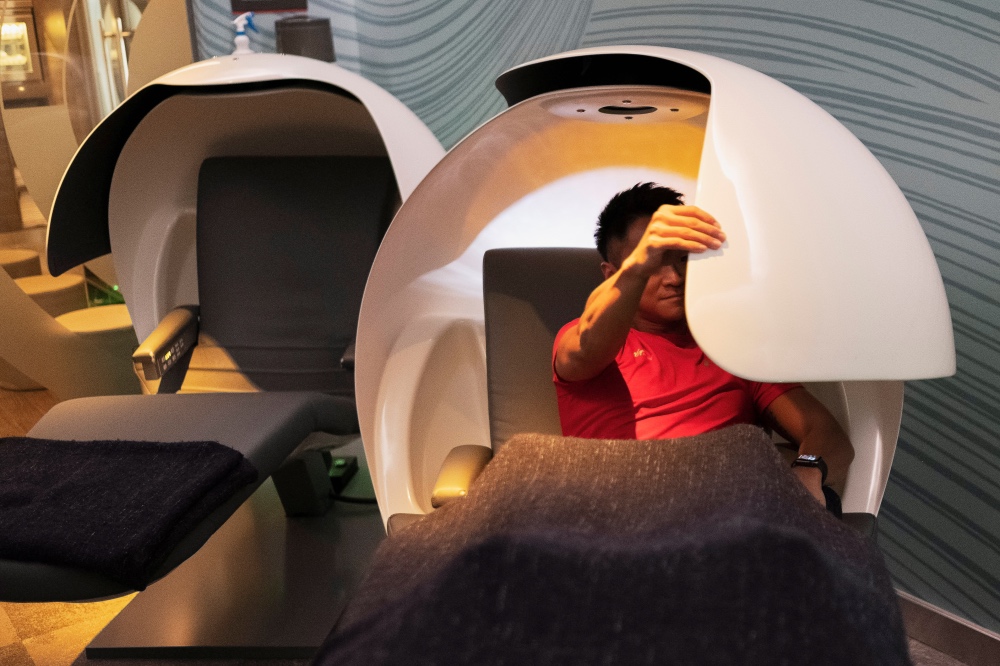Tbilisi, Georgia
Thomson Reuters Foundation
A critical shortage of affordable housing in cities across the world has forced many people to tap such unexpected resources as shipping containers and concrete pipes just to put a roof over their head.
At least 150 million people, about two per cent of the global population, are homeless according to United Nations data while more than 20 per cent of the population lack adequate housing. Many live in cities.

A Virgin Active employee adjusts the privacy visor of a MetroNaps EnergyPod as he demonstrates the use of the equipment for power naps at their fitness club in central Singapore, on 5th March. PICTURE: Reuters/Loriene Perera
As the UN marked World Cities Day on Thursday, here are eight dwelling types which highlight how cities are coping with housing crises:
Cage homes
Hong Kong’s property prices have rocketed more than 200 per cent in the past decade driven by limited housing supply and large capital flows from mainland Chinese buyers, forcing some of the city’s poorest to live in often squalid conditions. Tens of thousands are crammed into rooftop shanties, so-called cage homes with plywood bunk beds, or into tiny partitioned flats averaging just six square metres.
Sleeping pods
As rising prices push city workers to live further from the centre and endure long commutes, sleep pods which allow for a power nap near the office have popped up from Madrid and London to New York. In the British capital, start-up Pop & Rest offers busy travellers, flagging party-goers and restless new parents a bed in a tiny dark room scented with lavender and outfitted with ear plugs and eye masks for less than £20 an hour.
Garden homes
As part of a project to help refugees find homes in France, local non-profit Quatorze has installed tiny wooden houses insulated with cardboard in some Paris backyards. The first was set up in a family’s garden in the eastern suburb of Montreuil in 2017, with an Afghan refugee as its tenant. A second was installed at the back of an art gallery in the same district earlier this year.
Granny flats
A growing number of homeowners in the US capital of Washington – among the country’s most expensive cities – have turned townhouse basements or garages into small living units to rent out, often to help cover mortgage costs. Known as granny flats, mother-in-law suites or English basements, these conversions are gaining in popularity across the US as a way to boost affordable housing, according to property experts.
Live-in guardians
Up to 7,000 people are serving as guardians in empty properties across Britain, mainly in London, according to a 2018 report by the London Assembly, an elected body that scrutinizes the activities of the mayor. Guardians pay low rents in exchange for securing buildings from squatters and vandals, but sometimes live in poorly maintained mouldy homes with few legal protections, the report said.
Shipping containers
Thousands of homeless children in Britain are being forced to sleep in often overcrowded converted shipping containers that are “blisteringly hot” in summer and “freezing” in winter, a report by Children’s Commissioner for England said in August.
Egg house
A Chinese man named Dai Haifei made international headlines in 2010 when, unable to afford Beijing’s high rental prices, he lived for a few months in an homemade egg-shaped mobile house near his office in the city. The house was made of bamboo strips, steel bars, heat prevention and waterproof materials, sacks filled with fermented wood chips and grass seeds, as well as one solar panel, local media reported.
Water pipes
To ease Hong Kong’s housing crisis, a local architectural firm created micro homes in concrete water pipes that can be stacked under elevated roadways or between highrises. Measuring 2.5 metres in diameter, the pipes have been remade into nine square metre apartments for two, with a living and kitchen space, a shower and a toilet.
Sources: Reuters, Thomson Reuters Foundation, Quatorze, London Assembly, Children’s Commissioner for England





